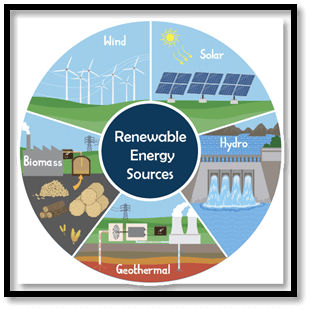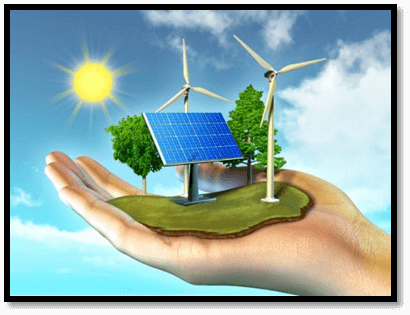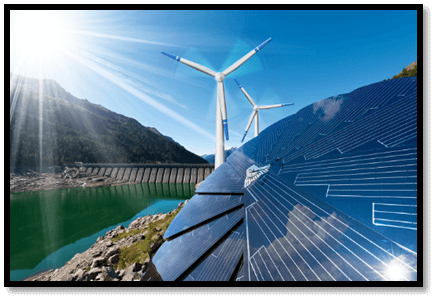Advantages and Disadvantages of Renewable Energy SourcesThe energy that can never run out or be exhausted, like the sun, is referred to as a renewable energy source. Renewable energy sources are frequently included when the term "alternative energy" is used. It refers to alternative energy sources to the most popular non-sustainable sources, such as coal. 
Here are some advantages and disadvantages of the same: Advantages of Renewable energy Sources1. Reliable source of energy The output from solar and wind power plants is evidently reduced significantly on cloudy and still days. But this can be avoided if a strong infrastructure is in place. There is evidence that distributing wind, solar, tidal, and thermal plants over a big geographic area minimises interruptions in power generation. This makes for a nearly ideal energy balance when combined with a baseload source of clean energy, like nuclear energy. Contrast this with fossil fuels, which pose a serious threat to the reliability of their energy production. Because they are a commodity, fossil fuels are susceptible to changes in the market. These factors could include things like war, trade conflicts, adjustments to energy regulations, political unpredictability, and adjustments to energy costs. A nation's economy and electricity policies suffer from these fossil fuel pricing and supply weaknesses. It doesn't take much for the failure of a fossil fuel supply to cause blackouts to spread throughout an area or even a whole country. The same dangers as with fossil fuels apply to the mining of energy for nuclear fission reactors. The source of energy is so dense, though, that a tiny amount of fuel is required to run a reactor. Unlike oil and gas, there is no danger connected to such market movements. The option of reprocessing used fuel is also available. This makes it possible to recycle 96% of the fuel. Reprocessing is an expensive but highly successful process. 2. Renewable energy sources are endless Renewable energy sources use only natural resources. There will always be more of the sun, wind, tide, and Earth's core. They are natural resources that are abundant and sustainable. Fossil fuel resources, however, cannot be regarded to be in this category because mining fossil fuels has a cost to the environment and to society. Future shortages of oil, gas, as well as coal are a distinct possibility. We can prevent the Earth's natural resources from running out by producing electricity from clean, renewable sources. We run the risk of losing the ability to produce energy in the near future if we continue to rely on fossil fuels. Renewable energy sources do not include nuclear power. But it is a renewable energy source. Nuclear fission reactors can be operated for millions of years if there is enough fuel available. Nuclear power has the potential to convert to renewable energy by capturing nuclear fuel for the ocean. A completely sustainable source of energy would also be made available via nuclear fusion. 3. Economical and profitable Cost savings are provided by renewable energy. As technology becomes more effective, this tendency is expected to persist. As a result, energy costs will keep declining. Large opportunities are presented by operating and maintaining efficiencies, as well as the absence of fuel costs. Savings in the hundreds of thousands are possible by harnessing the sun and wind energy. Fossil fuels, on the other hand, must be replenished, which raises the cost of fuel. Renewable energy sources will only get more affordable as technology develops and environmental concerns become more important. On the other hand, when fossil fuels become harder to come by and the possibility of a "carbon tax" materializes, their prices will begin to reflect this. Cost is currently the main drawback of nuclear energy production. It is frequently challenging to determine if a modern nuclear power station will be profitable given its construction expenses. 4. Generates employment opportunities The industry of renewable energy requires a lot of labour. As a result, it produces jobs. Given the creation of brand-new, long-lasting, steady jobs, this makes economic sense. In recent years, Germany has seen a rise in the number of occupations related to renewable energy. No matter how you feel about renewable resources, there is no denying that it generates a huge number of secure jobs. In contrast, fossil fuels have minimal labour costs, which increases the profit levels of energy production. It is well-known that renewable energy invests in its employees, adding to the number of employment created. Local businesses that succeed as a result of the field of renewable energy frequently provide advantages to the community as well as raise local earnings. 5. Involves Lower Maintenance Costs For renewable energy sources, less maintenance is required. Most of the time, this is true. Wind turbines and solar panels both have few to no moving parts. Additionally, they don't use combustible fuels. Reduced maintenance results in time and cost savings. Therefore, running expenses are typically minimal. Large earnings for the operators and affordable electricity for customers result from this. 6. Numerous environmental and health advantages Windmills in the picturesque, verdant countryside are often depicted in media about renewable energy. This description is accurate because renewable energy sources don't release pollutants into the atmosphere. The environment will benefit greatly from this. To represent fossil fuel energy sources, black smoke plumes are used. They produce a lot of greenhouse gases, which explains why. Additionally, they send additional dangerous contaminants into the air. It has been demonstrated that this raises global temperatures and increases the frequency of severe weather events. Our dependency on fossil fuels is decreased by renewable energy. This lessens the carbon footprint connected to the production of energy. It has positive effects on overall health by lowering airborne hazardous contaminants. When you think about how much money the government spends on health care. Clean, renewable energy seems like a no-brainer. This statement applies to nuclear energy. Clean energy includes nuclear power. No air pollutants or greenhouse gases are released as a result of nuclear energy. 
7. Strengthens Communities Communities are putting green energy at its core, contributing a fair portion of the power produced by community-led projects. Customers so pay a reasonable amount for electricity. Similar encouragement is given to providers to support regional economies. Remote areas are typically where renewable energy is found. However, they assist the local community in social and economic ways. Since such cultural values are situated at the core of the renewable power business, investment in the sector is frequently considered a component of the provider's social impact strategy. Historically, nuclear energy has been installed in outlying areas. Nuclear power plants' environs prosper by giving locals access to lucrative employment options and entrepreneurial prospects. 8. Reduces Dependency on Imported Energy Renewable energy is local energy, and that's why one don't depend on foreign energy. A nation that uses renewable energy sources may be independent. It might not appear to be a significant deal. However, it has a significant impact on every nation's economy. A stronger economy results from a decrease in dependency on imported energy. In the UK, this is particularly accurate. The UK has changed from being a major exporter to being a net importer as a result of the fall in North Sea output. Over the past three decades, this transformation has taken place. In terms of non-renewable oil and gas, the UK is now dependent on Russia and Norway. Importing this would cost extra as a result. Kazakhstan, Canada, Australia, as well as Russia are the main countries where nuclear fuel is mined. Frequently, the gasoline being used has an international origin. However, nuclear energy offers a way to become less dependent on imported energy due to the amount of fuel required within one nuclear reactor and also the relative simplicity with which it may be stored. 9. Global Energy Prices have been stabilized The initial construction stage is where renewable energy's expenses are the highest. There is no dependency on outside resources as soon as the technology is put into use. This indicates that the cost of energy is steady over the world. Like with fossil fuels, there are no variations because of the fuel's availability. Nuclear energy is in a similar scenario to this. There are times when gasoline needs to be replenished. But compared to fossil fuels, the amount of fuel required is less. Additionally, you can reuse about 95% of burned fuel if a nation uses reprocessing. 10. Technology exists in renewable energy. Renewable energy will eventually be more affordable than any other technology. The price will decrease as a result of enhanced production and installation procedures. There is currently technology for solar, wind, hydro, and thermal energy. These places have received significant government and industry investment. Efficiency will undoubtedly follow. In terms of innovation, the nuclear energy industry is currently the most fascinating in the world. The modern nuclear reactors of the fourth generation have undergone gradual upgrades. Small Modular Reactors, a product of the fifth generation, contribute to this. With all of these inventions and the dedication to creating numerous unique systems, nuclear energy will become more economically viable. This does not take into account the continuing nuclear fusion race developments. 
Disadvantages of Renewable EnergyNumerous advantages come with renewable energy but it's not all good. The following are some drawbacks of renewable energy: 1. Heavy Investment needed for installment Creation, construction, installation, and proper planning are required for generation of renewable energy. Facilities, such as solar cells, hydroelectric power plants, and wind turbines, for the generation of renewable energy are quite expensive. Remote locations are frequently used for renewable energy. This results in higher power line costs to transport the generated electricity to cities and towns. They will generate savings over time. However, they are expensive. It is frequently challenging for nuclear energy to show that it is commercially viable. The initial costs for contemporary nuclear new plants are very high. Additionally, they can take much longer to complete than anticipated. This is a difficulty. 2. Issues with unreliable renewable energy The fact that renewable energy is completely dependent on the weather is one of its drawbacks. A pleasant day, Night-time, or a dry-cloudy afternoon. Any one of these causes a disruption in the creation of renewable energy. The weather is unpredictable in every way. Extreme weather events can affect an electrical grid that is overly dependent on renewable energy. A wind turbine can only be moved by the wind. To produce solar electricity, you need a clear sky during the day. To provide flowing water, a dam must contain enough water. Renewable energy sources cannot be switched on and off at will, except Nuclear energy and Fossil fuels. 3. Storage capacities are required to facilitate renewable energy Renewable power sources are unreliable. There is a requirement to offer a backup. Although there are storage technologies accessible today, they are expensive. Any generated energy in a battery that is not stored will be lost. If used frequently, the batteries themselves quickly degrade and lose their effectiveness. Battery engineering is progressing. However, it is still a long way from being a practical support system for renewable energy. Currently, this backup is provided by fossil fuels. This can no longer be a source of carbon-free energy. The only clean, renewable energy supply that can offer a reliable energy source, whether it's sunny or not, is nuclear energy. 4. Regional restrictions There is a lot of room required for renewable energy. Approximately 2 megawatts of power are produced by 10 acres of the land area of solar panels. A wind farm would require 1.5 acres to produce the same amount of energy. In contrast, a nuclear power station would generate 850 megawatts in the exact same amount of space. The geography of the world is varied. Various forms of renewable technologies are better suited to various climes and environments. There isn't a fix that works for everyone, such as huge wind farms spread out over a big open area, residential properties with solar panels in warm climates, and thermal power plants near active volcanoes, they all share the same trait. They need loads and plenty of space. 5. The efficiency of renewable energy is low Technologies for generating renewable energy have existed for a while. However, the widespread application of the technology has just recently been implemented. As a result, technological inefficiencies persist. Costs and future investment generation are concerns caused by this. Grants and subsidies are offered by several nations to enable the development of renewable technology. For example, consider wave power. Numerous studies have been done on the possibilities for wave power. The difficulty of conducting business underwater comes with this. Seawater provides a new challenge to being underwater, which is difficult enough without it. Achieving high efficiency is challenging because of corrosion problems and challenges with utilizing both horizontal and vertical sea movement. Without requiring a lot of fuel, the usage of a source of energy is so dense. The capacity to recycle used fuel. Nuclear energy is among the most efficient options available when combined with a constant energy supply. Nuclear energy will become the preferred technique as a result of recent initiatives aimed at capturing hydrogen and, thus, the heat produced during the process. 6. Pollution is still produced Although fossil fuels may have lower emissions than renewable energy, neither source is pollution-free. Many renewable energy sources or the processes used to make them release greenhouse gases into the atmosphere, such as carbon dioxide or, worse, methane. It is partially because fossil fuels provide the resources required for renewable energy. However, not all renewable resources are clean, such as biomass, which releases organic materials into the atmosphere when burned. |
 For Videos Join Our Youtube Channel: Join Now
For Videos Join Our Youtube Channel: Join Now
Feedback
- Send your Feedback to [email protected]
Help Others, Please Share










